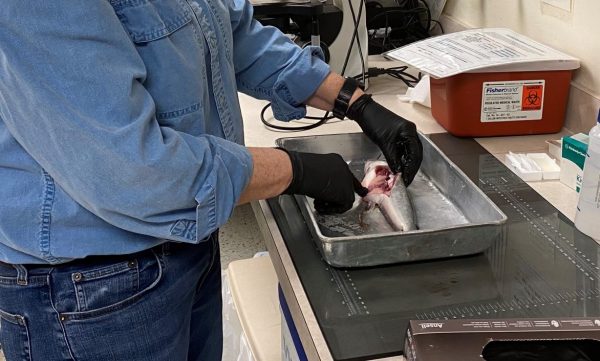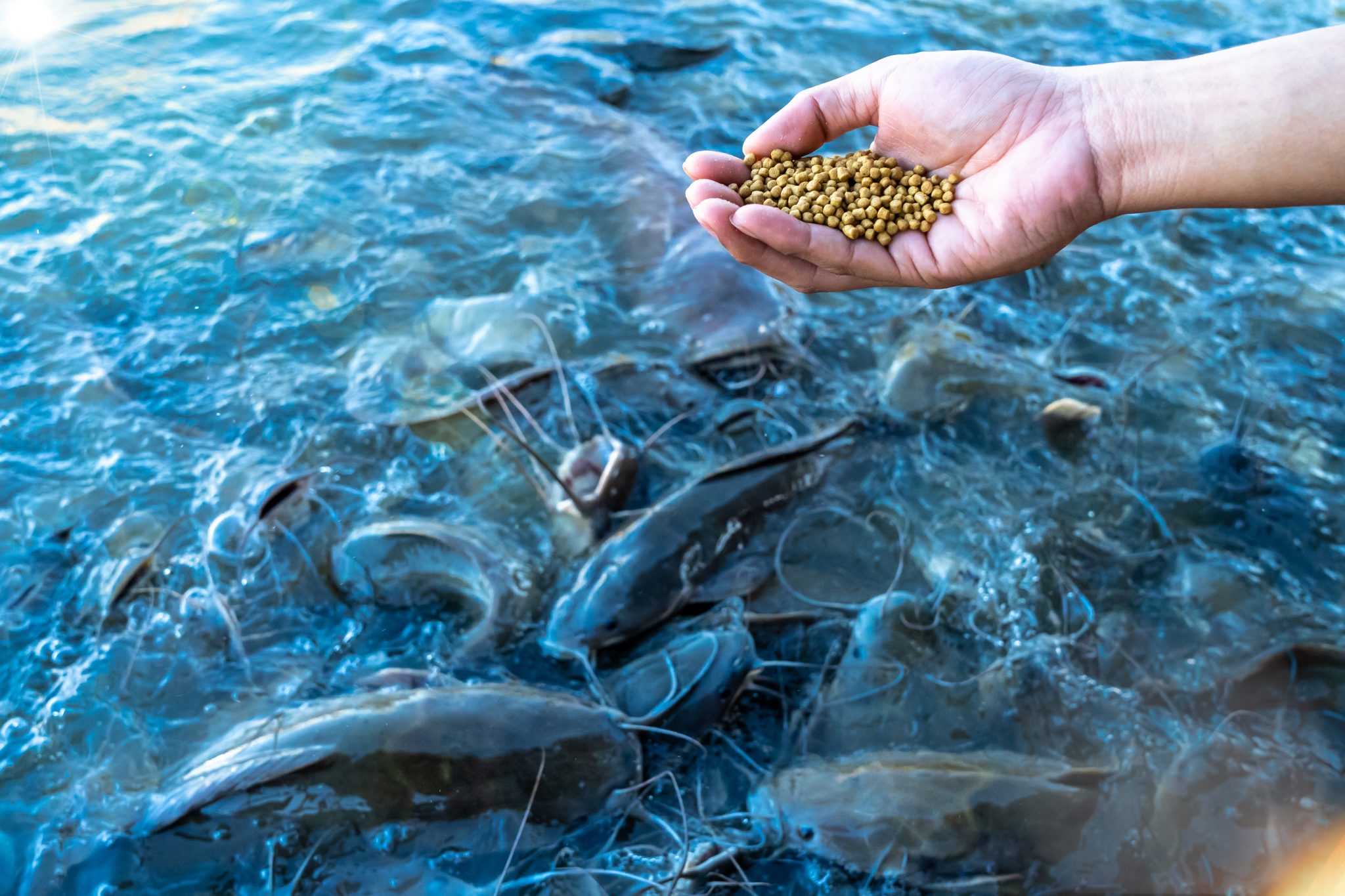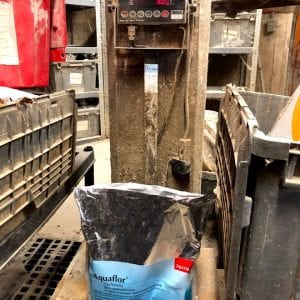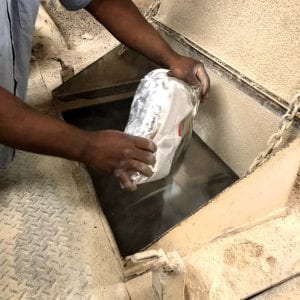Fish & Water

Catfish farming is an important industry for the economy of Alabama. Success requires diagnosis and treatment of the diseases that are prevalent to catfish populations.

Figure 1. Catfish farming is an important enterprise in the Black Belt Region of West Alabama.
Alabama ranks second in the United States in catfish production and water acres devoted to catfish farming. Currently, sixty-six farms produce catfish on approximately 16,000 water acres of ponds. Most are in the Black Belt region of West Alabama (figure 1), where it is a significant source of jobs and income for families.
Each year farmers must contend with several diseases that afflict their catfish and potentially cause substantial financial losses. Disease diagnosis is often difficult, and effective treatments can be expensive.
The primary diseases faced by catfish farmers in Alabama include columnaris (Flavobacterium columnare), Aeromonas (virulent Aeromonas hydrophila), and enteric septicemia of catfish (ESC; Edwardsiella ictaluri). These bacterial diseases resulted in a combined $13.7 million in lost profits to Alabama catfish farms in 2020. Fortunately, antibiotics are available to fight these three fish diseases. We will cover the three antibiotic feeds available for catfish farmers to fight columnaris, virulent Aeromonas spp., and ESC.
Diagnosis and Treatment with Medicated Feeds

Figure 2. Proper pathogen identification by a qualified aquatic animal health specialist is an important step in obtaining a veterinary feed directive (VFD) for an antibiotic prescription from a local veterinarian.
To diagnose diseases affecting their catfish, farmers typically transport a few fish samples from the problem pond to a diagnostic laboratory such as the Alabama Fish Farming Center. The fish health specialist performs a series of tests on the sick fish to determine which disease is responsible (figure 2).
The catfish industry currently can use some antibiotics to treat fish, depending on which disease is diagnosed. If the disease (such as virulent Aeromonas spp., columnaris, or ESC) can be treated with medicated feed, the farmer can request that the fish health specialist write and send a report to the farmer’s veterinarian.
Medicated feed is simply a standard catfish feed produced with the addition of antibiotics designed to combat specific disease pathogens. A veterinary feed directive (VFD) is required for all medicated feed used in aquaculture. Veterinarians that have an established veterinarian-client relationship with the producer will write a (VFD) and send it to the farmer and the feed mill. The feed mill will make the medicated feed and deliver it to the catfish farm (figures 3 to 5).
Following the delivery of the antibiotic feed to the farm, the feed is administered by the commercial producer for a set number of days depending on the antibiotic prescribed (figure 6). Proper diagnosis is the key to obtaining the appropriate antibiotic for use in treating the disease. The extra-label use of antibiotic feeds is illegal.
- Figure 3. Antibiotics are weighed out at the feed mill prior to adding to commercial catfish feeds.
- Figure 4. Antibiotic is added to the mixer at a commercial feed mill in West Alabama.
- Figure 5. Antibiotic feed is delivered to catfish farms and stored in commercial feed bins prior to feeding catfish.

Figure 6. Once the antibiotic feed is received on the farm, catfish are fed using a feed truck equipped with a blower for a specific number of days depending on the antibiotic prescribed.
Approved Antibiotics
Aquaflor
- Aquaflor (florfenicol) is an antibiotic produced by Merck Animal Health (Kenilworth, New Jersey; merck-animal-health-usa.com) labeled to control columnaris in catfish and other finfish species. Aquaflor is labeled for the control of ESC in catfish (table 1). It can be fed to both fingerlings and food fish. It is used most commonly in floating catfish feeds but can also be used in sinking feeds. This particular antibiotic must be fed for 10 consecutive days and has a 15-day withdrawal period. VFDs for this antibiotic expire after six months. In some cases, this antibiotic has been effective for treating fish with both columnaris and Aeromonas hydrophila, but it is not currently labeled for treating Aeromonas spp.
Table 1. FDA-approved Antibiotics for Use in Catfish Aquaculture
| Antibiotic Active Ingredient (Trade name) | Treatment Uses | Treatment and Withdrawal Periods | Storage Conditions |
|---|---|---|---|
| Florfenicol (Aquaflor) | Columnaris disease Enteric septicemia of catfish (ESC) Streptococcus infections | Feed for 10 consecutive days 15-day withdrawal period | Store at temperatures up to 77°F with occasional storage permitted to 104°F |
| Sulfadimethoxine/ormetoprim (Romet 30 and Romet TC) | ESC | Feed for 5 days 3-day withdrawal time | Store dry at or below 77°F with occasional storage permitted to 99°F |
| Oxytetracycline (Terramycin 200) | Aeromonas, Pseudomonas infections | Feed for 10 days 21-day withdrawal time | Store at room temperature (77°F) |
Romet
- Romet (sulfadimethoxine and ormetoprim) is produced by AquaTactics Fish Health (Kirkland, Washington; aquatactics.com) and is labeled for treating ESC in catfish. Romet is available as two separate products: Romet 30 and Romet TC.
- Romet 30 is the traditional feed formulation that feed mills have used for many years. Compared to other antibiotics available for catfish farmers, Romet has a much shorter depletion time in the fish and only a 3-day withdrawal period.
- Romet TC (Top Coat) is a version of the same antibiotic that improves the taste of the feed, resulting in increased consumption of the medicated feed by catfish. Romet TC can be applied at the feed mill or self-applied at the farm if you have a valid medicated feed mill license from the Food and Drug Administration. Romet is fed at either 2 or 3 percent body weight of the fish per day.
Terramycin 200
- Terramycin 200 (oxytetracycline hydrochloride) is a broad-spectrum antibiotic produced by Phibro Animal Health (Teaneck, New Jersey; phibroah.com). It effectively treats bacterial hemorrhagic septicemia in catfish caused by Aeromonas and Pseudomonas infections, including Aeromonas hydrophila. This antibiotic can be administered to both sinking and floating feeds.
- Treatment of catfish with Terramycin 200 requires a 10-day treatment period followed by a 21-day withdrawal time. The withdrawal period for this antibiotic is the longest of the three available antibiotics; however, it has been proven very effective for treating the diseases for which it is labeled. Terramycin is also the least expensive of the available antibiotic options.
Minor Use and Minor Species Act of 2004
Minor use drugs are meant to be used in horses, dogs, cats, cattle, pigs, turkeys, and chickens, which are referred to as major species. They are to be used
in limited circumstances, such as rare diseases or diseases confined within a small area, and in only a few animals annually. Minor species are all animals other than humans that are not one of the major species. They include some agriculturally important animals, such as sheep, goats, catfish, game birds, and honeybees.
The Minor Use/Minor Species Act (MUMS) benefits catfish producers. Before MUMS many drug companies did not want to invest the money to obtain approval for a catfish drug, as the market is too small to generate an adequate financial return.
Summary
Antibiotic feeds are an effective tool for treating several diseases in catfish. Unfortunately, the availability of only three antibiotics for use in our tool kit is problematic, particularly since antimicrobial resistance has become more prevalent in aquaculture.
Antimicrobial resistance is a microbe’s ability to survive an antimicrobial agent (such as an antibiotic) that was previously an effective treatment. It is essential for farmers to avoid antimicrobial resistance in order to feed antibiotic treatments for the required number of days as dictated by the label and the VFD.
For more information on the proper application of antibiotic feeds on catfish farms, see “Using Medicated Feeds in Catfish Aquaculture” on the Alabama Extension website or visit the Alabama Fish Farming Center website.
 Luke A. Roy, Associate Extension Professor, and Anita M. Kelly, Extension Professor, both in Fisheries, Aquaculture, and Aquatic Sciences, Auburn University
Luke A. Roy, Associate Extension Professor, and Anita M. Kelly, Extension Professor, both in Fisheries, Aquaculture, and Aquatic Sciences, Auburn University
New July 2021, Antibiotic Feeds for Catfish Farmers, ANR-2762




